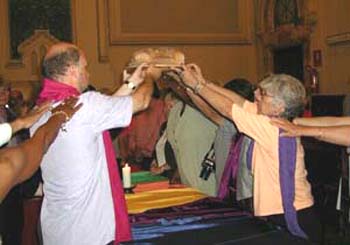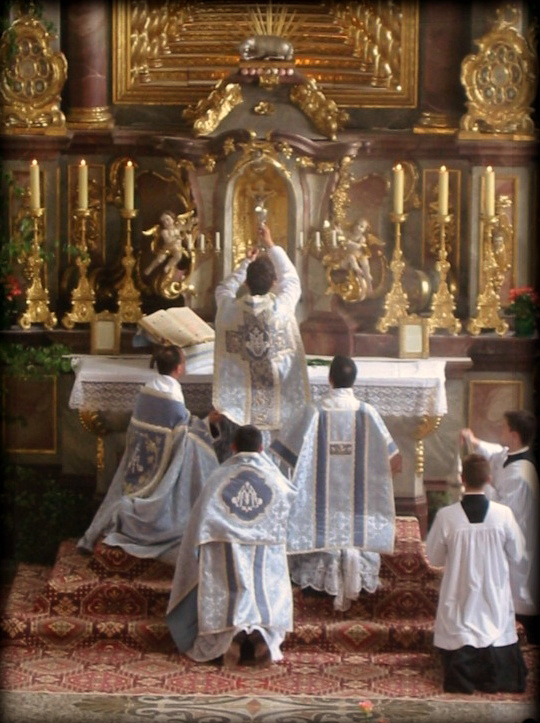| ABUSE |
1) What did the Church leaders really want to do through Sacrosanctum Concilium?
To begin with, one merely needs to look at the document for some hints on the intention of, at least, Pope Paul VI. Here is one snippet to look at first: what is obvious is that the Pope wanted more participation of the Faithful in the Mass, but notice the emphasis here on the clergy, who are to be "imbued with the spirit and power of the litugy" and, therefore, be able to teach the people.
What the power and the spirit of the liturgy may be could be open to discussion, but I would hope it would primarily be to all who read this the public worship of God in the Holy Sacrifice of the Mass, in reverence and in Truth.
In the restoration and promotion of the sacred liturgy, this full and active participation by all the people is the aim to be considered before all else; for it is the primary and indispensable source from which the faithful are to derive the true Christian spirit; and therefore pastors of souls must zealously strive to achieve it, by means of the necessary instruction, in all their pastoral work.
Yet it would be futile to entertain any hopes of realizing this unless the pastors themselves, in the first place, become thoroughly imbued with the spirit and power of the liturgy, and undertake to give instruction about it. A prime need, therefore, is that attention be directed, first of all, to the liturgical instruction of the clergy.
Liturgical instruction does not mean that the clergy is free to do what they want. As I have highlighted recently, too many clergy here abuse the Eucharist in Adoration with novelties, such as healing Adoration services, which violate rules of GIRM. Of course, we are all too aware of liturgical abuses in the Mass. One knows that where there is disobedience to the norms and a lack of respect for the Mass and the Eucharist, there is sin, not merely ignorance. Sin, not ignorance...
| ABUSE |
The complete revision, in the document called "restoration" was specifically stated in this document. This is the problem with many who want to defend the great changes, as the question may and should be asked, why was such a revision or "restoration" necessary?
Again, a snippet from the norms:
A) General norms
22. 1. Regulation of the sacred liturgy depends solely on the authority of the Church, that is, on the Apostolic See and, as laws may determine, on the bishop.
2. In virtue of power conceded by the law, the regulation of the liturgy within certain defined limits belongs also to various kinds of competent territorial bodies of bishops legitimately established.
3. Therefore no other person, even if he be a priest, may add, remove, or change anything in the liturgy on his own authority.
23. That sound tradition may be retained, and yet the way remain open to legitimate progress careful investigation is always to be made into each part of the liturgy which is to be revised. This investigation should be theological, historical, and pastoral. Also the general laws governing the structure and meaning of the liturgy must be studied in conjunction with the experience derived from recent liturgical reforms and from the indults conceded to various places. Finally, there must be no innovations unless the good of the Church genuinely and certainly requires them; and care must be taken that any new forms adopted should in some way grow organically from forms already existing.
As far as possible, notable differences between the rites used in adjacent regions must be carefully avoided.
24. Sacred scripture is of the greatest importance in the celebration of the liturgy. For it is from scripture that lessons are read and explained in the homily, and psalms are sung; the prayers, collects, and liturgical songs are scriptural in their inspiration and their force, and it is from the scriptures that actions and signs derive their meaning. Thus to achieve the restoration, progress, and adaptation of the sacred liturgy, it is essential to promote that warm and living love for scripture to which the venerable tradition of both eastern and western rites gives testimony.
25. The liturgical books are to be revised as soon as possible; experts are to be employed on the task, and bishops are to be consulted, from various parts of the world.
B) Norms drawn from the hierarchic and communal nature of the Liturgy
26. Liturgical services are not private functions, but are celebrations of the Church, which is the "sacrament of unity," namely, the holy people united and ordered under their bishops [33]
Therefore liturgical services pertain to the whole body of the Church; they manifest it and have effects upon it; but they concern the individual members of the Church in different ways, according to their differing rank, office, and actual participation.
27. It is to be stressed that whenever rites, according to their specific nature, make provision for communal celebration involving the presence and active participation of the faithful, this way of celebrating them is to be preferred, so far as possible, to a celebration that is individual and quasi-private.
This applies with especial force to the celebration of Mass and the administration of the sacraments, even though every Mass has of itself a public and social nature.
28. In liturgical celebrations each person, minister or layman, who has an office to perform, should do all of, but only, those parts which pertain to his office by the nature of the rite and the principles of liturgy.
29. Servers, lectors commentators, and members of the choir also exercise a genuine liturgical function. They ought, therefore, to discharge their office with the sincere piety and decorum demanded by so exalted a ministry and rightly expected of them by God's people.
Consequently they must all be deeply imbued with the spirit of the liturgy, each in his own measure, and they must be trained to perform their functions in a correct and orderly manner.
30. To promote active participation, the people should be encouraged to take part by means of acclamations, responses, psalmody, antiphons, and songs, as well as by actions, gestures, and bodily attitudes. And at the proper times all should observe a reverent silence.
31. The revision of the liturgical books must carefully attend to the provision of rubrics also for the people's parts.
32. The liturgy makes distinctions between persons according to their liturgical function and sacred Orders, and there are liturgical laws providing for due honors to be given to civil authorities. Apart from these instances, no special honors are to be paid in the liturgy to any private persons or classes of persons, whether in the ceremonies or by external display
......
 |
| ABUSE |
D) Norms for adapting the Liturgy to the culture and traditions of peoples
37. Even in the liturgy, the Church has no wish to impose a rigid uniformity in matters which do not implicate the faith or the good of the whole community; rather does she respect and foster the genius and talents of the various races and peoples. Anything in these peoples' way of life which is not indissolubly bound up with superstition and error she studies with sympathy and, if possible, preserves intact. Sometimes in fact she admits such things into the liturgy itself, so long as they harmonize with its true and authentic spirit.
38. Provisions shall also be made, when revising the liturgical books, for legitimate variations and adaptations to different groups, regions, and peoples, especially in mission lands, provided that the substantial unity of the Roman rite is preserved; and this should be borne in mind when drawing up the rites and devising rubrics.
There is more, but one can clearly see the huge departures from the TLM, although the Latin Participatory Mass had been in effect for many years before this 1963 document.
So, as to "intent", I think it is clear that the NO must be seen as a departure from the hermenuetic of continuity.
I suggest reading the rest of the norms here. http://www.vatican.va/archive/hist_councils/ii_vatican_council/documents/vat-ii_const_19631204_sacrosanctum-concilium_en.html
Remember, however, that Latin was and is the official language of the Church and the Liturgy of the Church and the TLM was never abrogated.
 |
| ABUSE |
The dogmatic principles which were laid down by the Council of Trent remaining intact [40], communion under both kinds may be granted when the bishops think fit, not only to clerics and religious, but also to the laity, in cases to be determined by the Apostolic See, as, for instance, to the newly ordained in the Mass of their sacred ordination, to the newly professed in the Mass of their religious profession, and to the newly baptized in the Mass which follows their baptism.
.....
 |
| Thanks to WikiCommons--Ancient Beauty |
Note as well, the pride of place given to Gregorian Chant and THIS has been ignored in most parishes and even in many cathedrals.
116. The Church acknowledges Gregorian chant as specially suited to the Roman liturgy: therefore, other things being equal, it should be given pride of place in liturgical services.
But other kinds of sacred music, especially polyphony, are by no means excluded from liturgical celebrations, so long as they accord with the spirit of the liturgical action, as laid down in Art. 30.
117. The typical edition of the books of Gregorian chant is to be completed; and a more critical edition is to be prepared of those books already published since the restoration by St. Pius X.
It is desirable also that an edition be prepared containing simpler melodies, for use in small churches.
118. Religious singing by the people is to be intelligently fostered so that in devotions and sacred exercises, as also during liturgical services, the voices of the faithful may ring out according to the norms and requirements of the rubrics.
2) How could the liturgy as it stood, as the TLM, been "tweaked" to help Catholics who were wanting the Mass in the venancular?
I cannot see that anything needed tweaking. As one who grew up in a TLM time and when more converts were coming into the Church with the TLM in place, I am mystified by the changes, which IMO, were never necessary. The Latin Mass had been changed to allow for the participation of the people in the singing and answering of certain parts-again, what was called the Participatory Mass.
| The TLM is the Mass of the Ages |
3) Why can't bishops see the exodus from the Church and the lack of converts as connected to the NO?
I have come to the conclusion that a lack of discernment in any Catholic is owing to hidden sin and the refusal to allow God to purify one. Discernment is totally lacking in so many "leaders", we are spoiled for choice for examples of minds and hearts caught in a spiritual darkness. I cannot add to that.